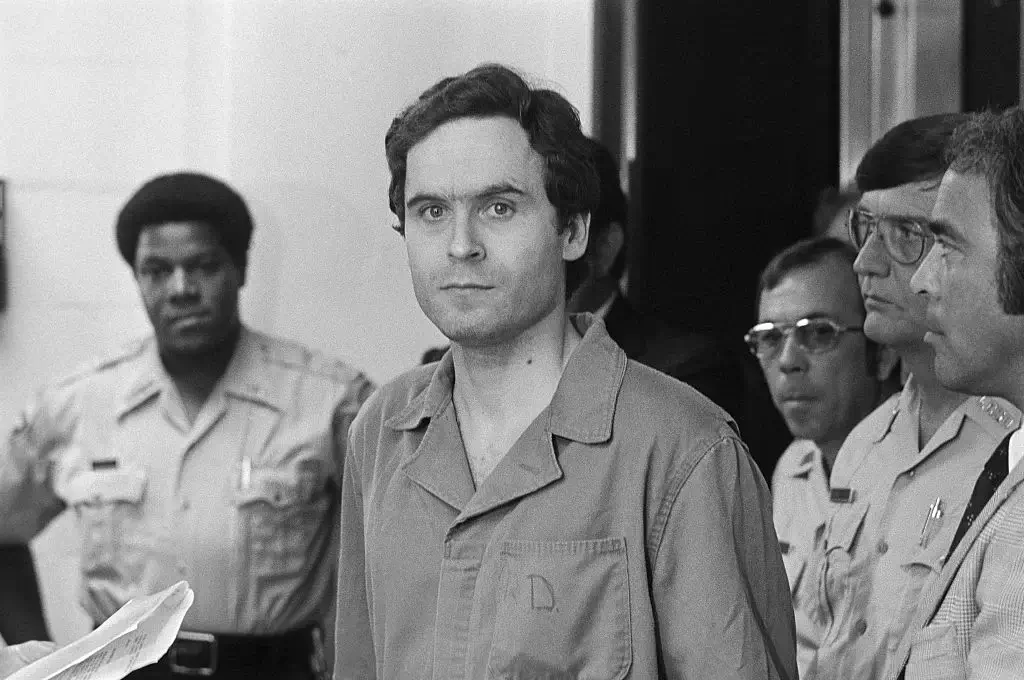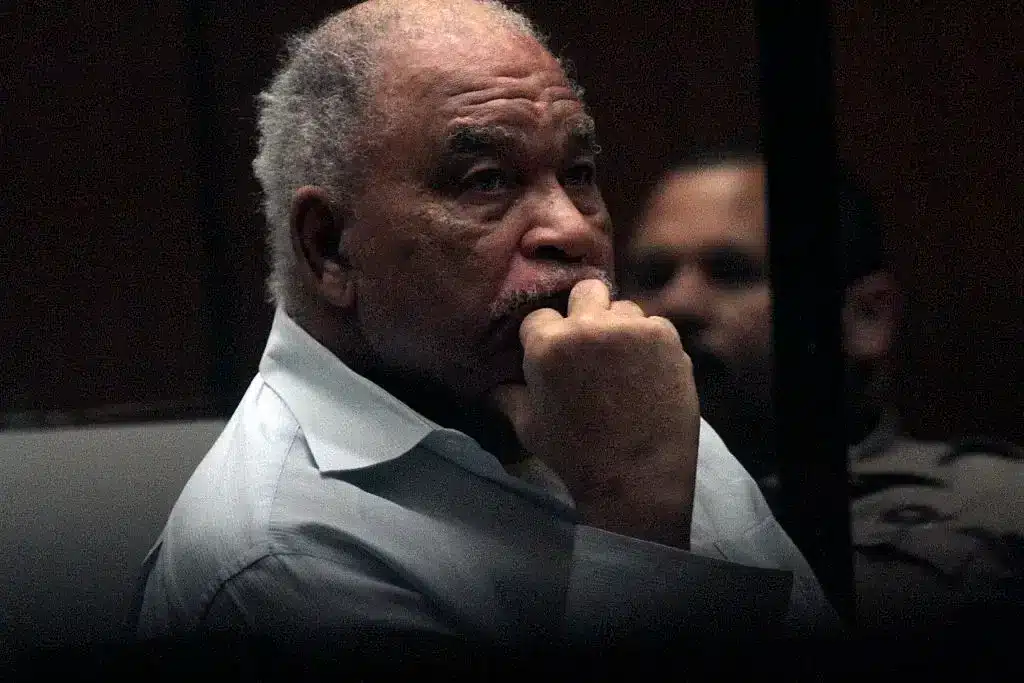
Dahmer – Monster: The Jeffrey Dahmer Story – Picture: Netflix
Thanks to the overwhelming success of Ryan Murphy’s Dahmer – Monster: The Jeffrey Dahmer Story, Netflix has renewed the true crime anthology for a further two seasons. But which infamous American serial killer will the anthology cover next?
It’s a sad truth, but America has a tragic history with serial killers. In an era of history that saw a meteoric rise in the consumption of media, serial killers became the subject of not only statewide but national debate. This also paved the way for some caught and convicted serial killers to be given a near celebrity-like status.
Our fascination with serial killers has inspired and led to the creation of many films, television shows, documentaries, and true crime podcasts. In fact, some of the most popular content on Netflix is related to true crime, such as Ryan Murphy’s crime anthology Monster, which is the streaming service’s second most-watched series ever.
With Monster renewed for a second and third season, the question is “which infamous serial killer does the series cover next?”. We’ve taken a look into some of America’s most infamous serial killers, and created a list below of what we think Ryan Murphy will adapt the story of next.
Ted Bundy

(Original Caption) Suspected murderer Theodore Bundy, charged with the killings of FSU coeds Margaret Bowman and Lisa Levy who were beaten and strangled at the Chi Omega House in January, is shown in this photograph.
Very few adults in the world are strangers to the story of Ted Bundy.
As one of the most infamous serial killers in American history, this has led to many film adaptations of his crimes and the subject of documentaries.
Ted Bundy’s killing spree took place over the course of five years between 1974 and 1979. He admitted to the murder of 30 women, however, it is believed by the authorities that the true death toll is in the region of 100.
While the subject surrounding how good-looking Bundy was is completely subjective, one thing many agreed on was his ability to charm people, and his ability to exploit this to his advantage. By winning the trust of his victims, he could carry out his crimes, and by winning the trust of the public, Bundy could feign innocence, and earn sympathy.
Bundy escaped from captivity on multiple occasions, eventually making his way from Colorado, to Chicago, and then to Florida where his killing spree continued. When Bundy was eventually arrested and put on trial for murder in June 1979, his trial became the first in American history to be televised nationally. In total, it was reported that 250 journalists from five different continents were covering the trial.
Bundy was found guilty by the jury of his crimes and was sentenced to death by electrocution. Prison wouldn’t stop Bundy from being the center of attention. During his captivity, as he waited for his execution, Bundy would conduct a series of interviews, confessing to his crimes, and would also try to aid the FBI in their search for the Green River Killer.
He was executed by electrocution in 1989.
The sad truth is, much like Dahmer, the story of Ted Bundy is morbidly fascinating. And, while his story has been told over and over, Ryan Murphy has a talent for offering a new perspective into true crime stories, especially when the focus is shifted away from the serial killer, and given to victims.
John Wayne Gacy

John Wayne Gacy on Dec. 21, 1978, at the Des Plaines Police Department. (Des Plaines Police Department/Chicago Tribune/Tribune News Service via Getty Images)
Thanks to the appearance of John Wayne Gacy in an episode of Dahmer, many are already speculating that America’s “Killer Clown” will be the focus of the second season of Monster.
Active between the years 1967 to 1978, there were thirty-three known victims of Gacy’s crimes, all of which were young men and boys. Before he was arrested and charged, Gacy had been known to perform at children’s hospitals and charitable events dressed as “Pogo” or “Patches the Clown.” As a performer, he would trick victims into handcuffing themselves, who were under the impression he was going to show them a magic trick. Once incapacitated, he would carry out his monstrous crimes.
Upon his arrest in 1978, the police would investigate his suburban Chicago home, finding 26 victims buried in the crawl space of his home, along with three more buried on the property, and four further victims found in the Des Plaines River.
In a drunken and hazy confession, Gacy eventually confessed to his crimes. However, during his trial, Gacy’s lawyers insisted on him pleading not guilty by reason of insanity. This led to Gacy’s diagnosis as a paranoid schizophrenic with multiple personality disorder when three psychiatric experts, who had examined him previously, were called by the defense.
After two compelling closing arguments by the defense and prosecution teams, the jury would find Gacy guilty on all accounts. As the Illinois statute for capital punishment had only come into effect in June 1977, for any murder Gacy committed after the law came into effect, he was sentenced to death.
During his years on death row, Gacy had on multiple occasions attempted to appeal against his conviction but was overturned every step of the way.
14 years after his trial, in May 1994 Gacy was executed by lethal injection. His last words were reported to be “Kiss my ass.”
Like Bundy, Gacy has been the subject of television and film adaptations. None of the film or television adaptations have earned major recognition, except for many of the true-crime documentaries based on his crimes.
Dennis Rader – BTK

WICHITA, KS – MAY 3: Dennis L. Rader (R), suspected of being the BTK serial killer, is escorted from the Sedgwick County courtroom after his arraignment May 3, 2005 in Wichita, Kansas. Rader, charged with 10 counts of murder, entered a plea of not guilty on all counts. (Photo by Bo Rader-Pool/Getty Images)
Between the years 1974 and 1991, Dennis Lynn Radar, aka the “BTK Killer” murdered a total of ten people in Wichita and Park City, Kansas.
Had it not been for his own ego, Rader may have gotten away with his crimes. Over the course of his killing spree, Rader had taunted the police and the media by sending letters and postcards. Some with extremely intimate details of the crimes.
His tenth and final victim, Dolores E. Davis, was murdered on January 19th, 1991. Rader then went on a decade-long hiatus, which led to the investigation of the BTK Killer becoming a cold case.
Over a decade later Rader would resurface, further taunting the media and the police. However, this would ultimately lead to his downfall. After sending a letter enquiring if a floppy disk could be traced, the police responded to “BTK” in a newspaper ad notifying him it would be safe to use. Upon sending the floppy disk to Fox affiliate KSAS-TV, it was passed on to the police, who were then able to find metadata embedded in a deleted Word document containing the words Christ Lutheran Church. The document was also marked as last modified by “Dennis.” A quick search from the police and they had found their number one suspect, Dennis Rader.
However, as the evidence was circumstantial they couldn’t arrest Rader with further evidence. The police were able to obtain a warrant to test the pap smear taken by Rader’s daughter at Kansas State University. The DNA sample from the smear test and the DNA sample from the fingertips of the victim Vicki Wegerle were a familial match, which gave the police enough evidence to arrest Dennis Rader.
Rader was charged with ten counts of murder and was sentenced to 175 years (ten life sentences) for his crimes. As the death penalty was not reinstated in Kansas until 1994, Rader could not be charged with the death penalty, as all of his crimes took place beforehand. Rader is still currently serving his 175-year sentence in solitary confinement, where he is allowed one hour of exercise a day, and showers three times per week.
The only issue with an adaptation of the BTK Killer story is that it would step on the toes of Mindhunter. While that series is currently on an indefinite hiatus, there’s still a chance it could return in the near future.
Samuel Little

LOS ANGELES, CA – AUGUST 18, 2014: Samuel Little, who was indicted on charges that he murdered three women in Los Angeles in the 1980s, listens to opening statements as his trial begins on AUGUST 18, 2014. (Photo by Bob Chamberlin/Los Angeles Times via Getty Images)
State-hopping Sam Little was active for decades and during a 35-year crime spree, he has been connected and confessed to the murder of at least 93 women, the largest number of confirmed victims for any serial killer in United States history.
A serial killer who was constantly in the clutches of the police, on numerous occasions Little was charged with varying degrees of crimes, including murder.
Between 1961 and 2012 he was arrested on many occasions;
- Sentenced to three years in prison for breaking and entering a furniture store in 1961. Released in 1964.
- By 1975 Little had been arrested a total of 26 times across eleven different states for crimes such as; theft, assault, attempted rape, fraud, and attacks on government officials.
- In 1982, in Pascagoula, Mississippi, Little was charged with the murder of Melinda Rose LáPree. The grand jury declined to indict him for her murder.
- Extradited to Florida for the murder of Patricia Ann Mount, but was acquitted in 1984 due to the mistrust of witness testimonies.
- In 1984, in San Diego, Little was charged with kidnapping, beating, and strangling 22-year-old Laurie Barros, but she survived. One month later, he was found in the same location with another woman and was charged with both crimes. He spent only two and a half years in prison.
- His final arrest came in September 2012, at a homeless shelter in Louisville, Kentucky, and was extradited to California.
By using a sample of his DNA, the police were able to connect Little to the murder of three women from 1987, and 1989, Carol Ilene Elford, Guadalupe Duarte Apodaca, and Audrey Nelson Everett. Only a few months later the police would link Little to dozens of cold murder cases.
On September 25, 2014, Little was found guilty and was sentenced to life in prison without the possibility of parole. Despite the overwhelming DNA evidence, Little still tried to maintain his innocence. During his imprisonment, Little would confess to the murder of dozens of people, which allowed the police to solve cold cases across multiple states between 1970 and 2005.
Despite being one of the most prolific serial killers in recent American history, there have been no film or television adaptations of his crimes.
At the time of writing, the only series based on the crimes of Sam Litte was a five-part docuseries series named Confronting a Serial Killer from Starz.
Gary Ridgway

SEATTLE – DECEMBER 18: Gary Ridgway prepares to leave the courtroom where he was sentenced in King County Washington Superior Court December 18, 2003 in Seattle, Washington. Ridgway received 48 life sentences, with out the possibility of parole, for killing 48 women over the past 20 years in the Green River Killer serial murder case. (Photo by Josh Trujillo-Pool/Getty Images)
Known to the public as the Green River Killer, Gary Ridgeway was an active serial killer between 1982 to 1998 before his arrest in November 2021. Sadly, there’s also the possibility he was active as recently as 2001.
He had been married three times and had several ex-girlfriends over the years who had described his desire for intercourse as insatiable. Ridgeway admitted to having a fixation with sex workers, and despite complaining about their presence in his neighborhood, he would often solicit their services. However, his fixation went beyond intercourse, and many of his victims were sex workers and underage runaways.
Ridgeway was a suspect in the Green River Killer case as early as 1983, as a year prior he had been arrested on charges related to prostitution. He would pass a polygraph test in 1984, and three years later in 1987 Ridgeway gave a sample of his hair and saliva to the police.
It took a further 14 years before his collected DNA samples were used for DNA profiling. The DNA sample linked Ridgeway to four murders from twenty years earlier. This provided the police with enough evidence for an arrest warrant. Ridgeway was then arrested for the suspicion of murder in November 2001.
Two years later, Ridgeway pleaded guilty to 48 charges of aggravated first-degree murder as a part of his plea bargain to escape the death penalty, Ridgeway agreed to disclose the locations of the missing women. But in return, he received a sentence of life imprisonment in prison without the possibility of parole.
While he had been charged with a total of 49 first-degree murders, Ridgeway later confessed that the number of his victims was so vast that he had lost count. He is suspected to be responsible for the death of over 90 victims.
Ridgeway has been the subject of multiple films, TV shows, documentaries, and even music. In Netflix Original docuseries Catching Killers, the Green River Killer was the subject of an episode. The episode focused on the decades-long investigation into the murders, and how a breakthrough in criminal and forensic science brought Ridgeway to justice.
Which infamous American serial killer do you think Monster will cover next? Let us know in the comments below.


 Rating: TV-MA
Rating: TV-MA


